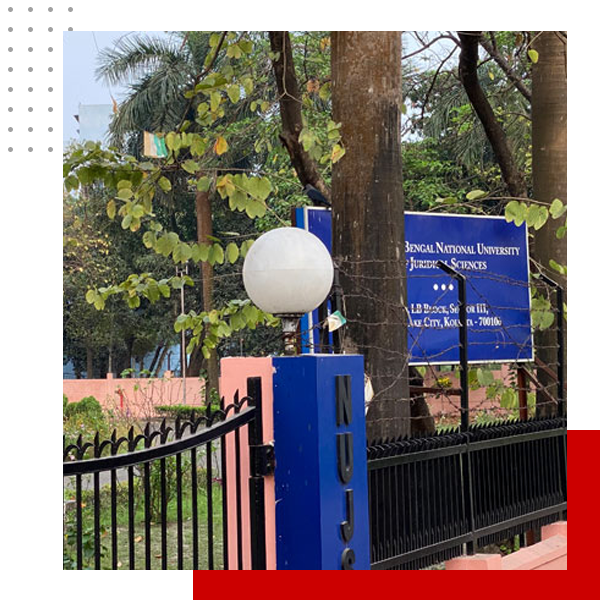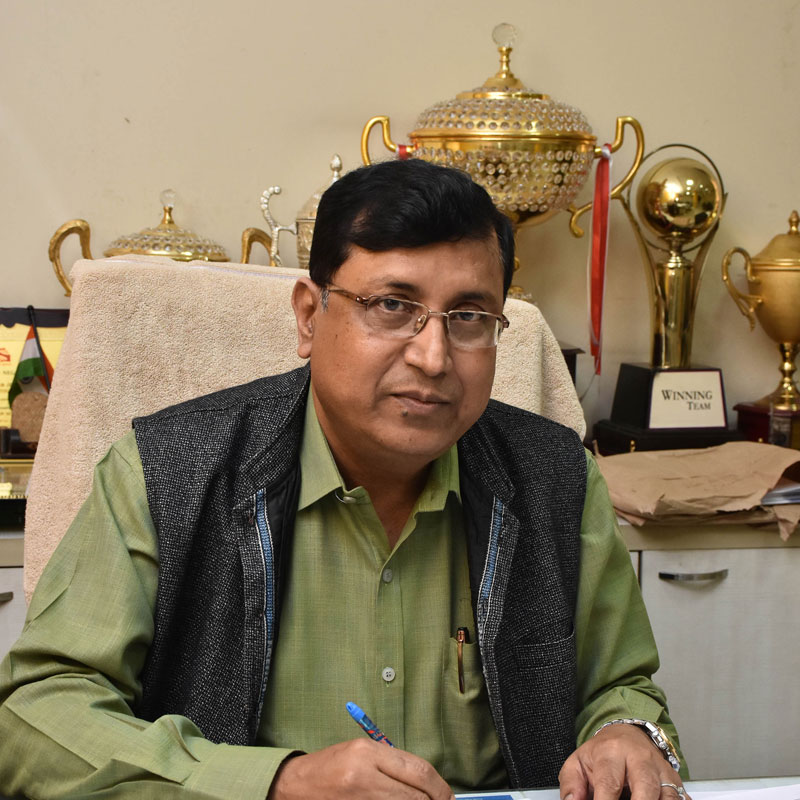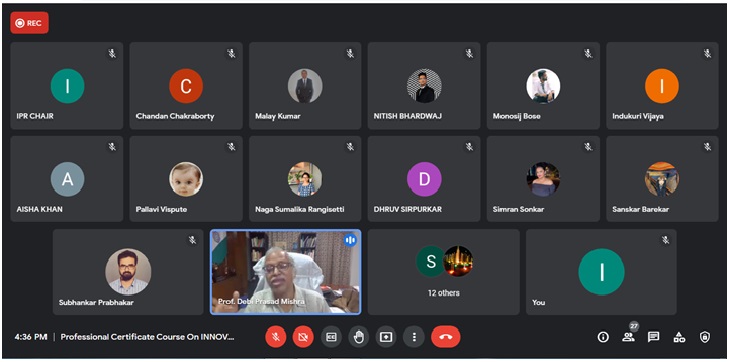


Prof. N K Chakrabarti
Vice Chancellor, WBNUJS

Dr. Pinaki Ghosh
DPIIT IPR Chair, WBNUJS

Dr. Jayanta Ghosh
Research Fellow, CRSGPP, WBNUJS

Mr. Partha Sarathi Chakraborty
Sr. Vice President, Copyright Society, DPIIT, GOI

ADG & IG of Correctional Services,
Govt. of West Bengal

Associate Professor,
Calcutta University

Founder and Managing Partner
LexMotion

Director, Food Processing Industries,
Govt. of West Bengal

IPS, Retired IG IB,
WB Police

Associate Professor, Kusuma School of Biological Sciences, IIT, Delhi

Joint Registrar, Kolkata,
National Company Law Tribunal
Application No: 846 Date of filing: 04/03/2022

Application No: 865 Date of filing: 11/04/2022


Application No: 875
Date of filing: 19/04/2022
Kolkata jewellery holds cultural significance in Bengali culture. There is various type of traditional Bengali jewellery, namely Nath, Kaan Baala, Patti Haar, Jhumko, Tairaa, Chik, and Chur. They are also essential in Bengali Bridal jewellery.
The jewellery are made using pure gold of 22 carat and above. Kolkata Jewellery is hand crafted. Kolkata Jewellery is collection of Conventional and traditional ornaments.
The design includes nature elements like Pata necklace (Pata Har), Ful Bala , ; animals like Hati Mukh pola (Elephant face) , Harin Bala (Deer) , Mayur Kan (Peacock Earrings ) daily use product like Chata Angti ( Umbrella ring ), Belt Neckless , Dori Chain and other items like Skha Badhano , Sita Har , Mantasha etc

Application No: 876
Date of filing: 19/04/2022

Lac belongs to the category of Minor forest Produces (MFPs). A significant number of farmers are dependent on lac cultivation for their livelihood resources. To the small and marginal farmers in the district lac is regarded as an important source of cash flow. The main two purposes which can be identified behind Lac cultivation are making it a family occupation and commercial marketing. The unique characteristics of Purulia Lac that distinguish it from that of other states of the country are as follows: Button lac and Shellac of Purulia is traditionally hand-made and the processing is simple in order to keep this insect resin as natural as possible.
Application No: 877
Date of filing: 19/04/2022
Handloom weaving is the main occupation of the residents of this village. The number of handloom weavers has dwindled from about 4000 in last decade to about approximately 2000 now, due to migration to other profession.
For a long time handloom weavers were producing a well-known sari variety, locally known as ‘matapar’ saris which means simple border without any ornamentation, woven with coarser cotton yarn (40s x 40s & 40s x60s ). These cheaper variety saris are mainly of coloured stripes and check patterns and with designs in the borders.
Begampuri sarees are woven in balanced texture with contrasting borders in red, black, purple, orange etc., emphasized by a serrated edge motif. Narrow to broader borders are woven with designs of variety of stripes and figured motifs using dyed cotton yarn. These broad borders known as ‘maathapaar’ or ‘Beluaaripaar’ were often in two colours- such as black and red with a compact weave thus making it more hardy.
Begampuri Saree can be distinguished by the presence of designs and ‘chiur’ (designs made by wooden pattayas) technique of weaving in some varieties. Contrast colours are usually arranged in body and borders.

Application No: 908
Date of filing: 21/06/2022

Application No: 937
Date of filing: 10/08/2022

Application No: 942
Date of filing: 17/08/2022

Application No: 990
Date of filing: 20/09/2022
Monohara is a flavorful dessert that looks like small pieces of sweet with a hard coating. It is made from cottage cheese (also known as chhana in Bangla), khoya and sugar. Basically it is a soft sandesh which is dipped in sugar syrup and once cooled; it forms a hard coating on top .For this sugar syrup coating the shelf life of the sweet increases. Normal sandesh can be stored for 1-2 days but this sweet can be stored 5-7 days without refrigeration.

Application No: 991
Date of filing: 20/09/2022

Application No: 992
Date of filing: 21/09/2022

Application No: 993
Date of filing: 27/09/2022

Application No: 1017
Date of filing: 06/01/2023

The empathy for conch has been eternally in craze since the Vedic age when human psyche realized an utter zeal for a philosophical and psychological uplift. The Conch shell is regarded as an inevitable instrument for performing the religious rites in many of the countries and occasionally it is blown to drive away evil spirits ensuing many of the religions. Traditionally, it represents the Indian marriage ideogram which has a greater value and ingeritance.
Bankura, with a treasure of an extreme passion for beauty and elegance, holds a distinct position in conch shell craft among all the conch carver communities all over India. These conch carving devotees have spent the whole of their lives creating astonishing designs on the shells. Either they have played up fabulous images of deities like Durga, Laxmi, Sri Krishna on each and every shell or they have put down an entire episode from an epic or a mythological story instead of a single motif. They also introduce floral or ornamental patterns for ornamentation with same dexterity. This craft of conch is undeniably a precious one and conveys Bengal’s heritage for its perception of beauty.
Application No: 1018
Date of filing: 06/01/2023

When it comes to sweet delicacies, none can beat Bengalis. Beliatore’s delicacy Mecha Sandesh is an exception and it is an outstanding Sandesh that is still made from ‘kheer’ and ‘chhana’ and rules the sweet kingdom. Not just that, the historical anecdotes related to this sweet maker’s creation is simply fascinating.
In it that the mecha is mainly made of besan that can be taken by a wide range of people even non lactose tolerant people along with its sugar coating which gives it a longer shelf life.The taste of besan mixed with sugar gives it an enhance in taste as well as glance.
Application No: 1041
Date of filing: 06/01/2023

The brinjal plant is a heat-loving, frost-sensitive bushy plant that branches out and has stems that are thick and woody. Large, lobed leaves that alternate with one another and range in colour from green to olive green are characteristic of this bushy herb. The undersides of the leaves are often covered in spiky fuzz. The flowers of the brinjal plant have the appearance of a star and come in a variety of hues of purple. They typically form on the opposite sides of the leaves of the plant, either singly or in clusters of two or more. They are flawless and, for the most part, capable of pollinating themselves. The Nawabganj brinjal has a texture that is entirely pulpy, and it contains very less seeds. This gives it a distinctively unusual character and flavour. The brinjal from Nawabganj has the same typical green colour as the brinjal from other regions. It has a flavour similar to sugar and is only available.
Application No: 1044
Date of filing: 13/01/2023

Murshidabad is famous for its historical remains and its ancestorial upbringings. Murshidabad have a great background of Emperial rules and has many traditional aspects for such. It is famous for its traditional hand works like Silk. Silk is cultivated at a very wide range and have different types of products which is known worldwide. The traditional hand practices of silk cultivation and the rearing of silk from raw silk cocoon make it more diligent and famous. The uniqueness in designs, patterns, quality and variants of the product exhibits Murshidabad Silk to be known as Silk Capital of India and marks its prominence worldwide.










 Users Today : 21
Users Today : 21 Users Last 7 days : 4214
Users Last 7 days : 4214 Total views : 1093230
Total views : 1093230© 2022 The West Bengal National University of Juridical Sciences, Kolkata | All rights reserved
| Cookie | Duration | Description |
|---|---|---|
| cookielawinfo-checkbox-analytics | 11 months | This cookie is set by GDPR Cookie Consent plugin. The cookie is used to store the user consent for the cookies in the category "Analytics". |
| cookielawinfo-checkbox-functional | 11 months | The cookie is set by GDPR cookie consent to record the user consent for the cookies in the category "Functional". |
| cookielawinfo-checkbox-necessary | 11 months | This cookie is set by GDPR Cookie Consent plugin. The cookies is used to store the user consent for the cookies in the category "Necessary". |
| cookielawinfo-checkbox-others | 11 months | This cookie is set by GDPR Cookie Consent plugin. The cookie is used to store the user consent for the cookies in the category "Other. |
| cookielawinfo-checkbox-performance | 11 months | This cookie is set by GDPR Cookie Consent plugin. The cookie is used to store the user consent for the cookies in the category "Performance". |
| viewed_cookie_policy | 11 months | The cookie is set by the GDPR Cookie Consent plugin and is used to store whether or not user has consented to the use of cookies. It does not store any personal data. |